As the world approaches another International Women’s Day, we reflect on this year’s theme — #InspireInclusion — and whether it stands up to scrutiny.
Have you ever watched the film Miss Congeniality?
Set against the backdrop of a Miss United States beauty pageant, the movie contains a scene in which the contestants are asked, “What is the one most important thing our society needs?” One by one, they each duly respond with a beaming smile and the words “world peace.”
Except the heroine, who attempts a different stance. She is met with silence.
There’s an awkward pause, and with a bewildered look in his eyes, the host looks down at his prompt cards ready to move on. But just in time, she decides to pivot her answer. “World peace,” she adds — this time greeted by the sound of rapturous applause.

All along, there was really only one acceptable answer to that question. No matter how removed from reality the response seemed.
For many of the same reasons, I struggle with the word “inclusion.”
Don’t get me wrong — I want the world to be inclusive. I believe, with every atom in my body, that no one should be made to feel like they don’t belong or that they can’t be true to themselves. It would certainly help this mama of two sleep better thinking my multiethnic, third culture girls might grow up in a society that genuinely embraces diversity.
But while I welcome the annual reminder to revisit diversity, equity and inclusion (DEI) discussions and gender parity, I find myself becoming victim to “inclusion fatigue.”
The inclusion façade
Let me explain. A couple of years ago, a colleague and I were approached by a prospect to revamp their website copy. As part of this, they needed some content around DEI for their careers page.
We organized a call to discuss their requirements and mine for material. But when we got to the DEI portion, the conversation went something like this:
Us: For the DEI section, do you have any existing materials we could review for reference? For example, HR materials, employee handbooks?
Prospect: No, we don’t have anything like that.
Us: OK, no problem. If there’s someone we can speak to about the initiatives you have in place, we can develop the copy from there.
Prospect: We’re not that mature. Why don’t you look at [competitor’s] website and see what they’ve written. We just need something generic — you can make it up.
Unfortunately, this was not the first time I’d come across this approach, nor was it the last.
Modern-day rhetoric has turned “inclusion”into a buzzword. And in today’s cancel culture, organizations seem so focused on toeing the line that they simply don’t take the time to consider its importance — or the fact that inclusiveness has a bearing on different issues in different countries and geographies. It becomes a tick-box exercise.
Which is perhaps why, even in the U.S., where the Black Lives Matter movement rocked the nation following the murder of George Floyd, DEI job listings are now down 19%. One U.S. study found that one in three DEI professionals lost their job in 2022 during mass layoffs compared to 21% of those in non-DEI roles.

Ethnocentricity and selective inclusion
For the DEI departments that have managed to avoid layoffs, another challenge awaits. Specific to multinationals, I have often found that certain voices and definitions of inclusion are louder than others.
This is typically driven by where an organization is headquartered and can, when not carefully managed, mean two things:
- Initiatives become ethnocentric: In other words, inclusion efforts are seen and celebrated through a single cultural lens, neglecting to take into account nuances from other markets around the world. A prime example would be the importance of supporting women from BIPOC communities in the U.S. to enter leadership roles. Companies in the West should absolutely be prioritizing this as a key issue. But if they have a global presence, they shouldn’t be using such initiatives as a standard calling card that unburdens them of further responsibilities. Localization is key.
- Funding becomes ethnocentric: With DEI departments slashed, the temptation may also be to centralize resources in one market. So while, in principle, businesses are happy to localize inclusivity efforts to cater to market nuances, employees are essentially left to mobilize and fend for themselves.
We have to beware that what “inspires inclusion” doesn’t become a top-down directive, shaped by only one cultural background. Otherwise, we’ll end up with selective inclusion, which … well, doesn’t sound very inclusive.
Enough talk — it’s time for action
For every grandstander, there’s a company who shows genuine care and compassion. I’ve been privileged to work with several such organizations.
Often, they start small. Perhaps even ethnocentric. But the important distinction is that they know their work isn’t done.
They welcome further conversation.
They welcome challenge and discomfort.
They put words into action.
Let me share a few examples. I was recently asked to conduct training for a semiconductor giant’s newly formed Women Initiatives Network. As I spoke to the women in the room about what the group entailed, they proudly shared how the company was investing in diversifying its hiring, improving its gender ratios and mentoring women to enter senior leadership. One woman was being mentored by the CEO himself. It was clear that they felt like the company had their back.
In another recent conversation, a female client shared that she had joined her company’s Pride Employee Resource Group (ERG) as its first Asia representative. They flew her out to San Francisco for the annual kickoff. In that same company, I was also able to comfortably approach the receptionist to ask for directions to their nursing room. They guided me to a dedicated space, complete with all the amenities I could possibly need.
I also want to give a shoutout to our partners at KeyNote Women Speakers, a nonprofit organization looking to bring more diversity to speaker stages. We’ve been working with the team for roughly a year now, helping them to promote their directory of incredible female speakers in a bid to put an end to tokenistic representation in panel discussions and trade shows.
These organizations aren’t just “inspiring inclusion” and adding to the corporate noise. They’re enacting it. No smoke and mirrors. No narcissism.
That’s how you light a fire. The question is, will you add fuel to the flame?
PS: At the end of Miss Congeniality, our heroine takes the stage to give a speech before her fellow contestants as they thank her for her part in averting a crisis (huge understatement). Looking upon the faces of her new friends as they welcome her into the fold, she’s visibly moved and intones, “I really do want world peace.” Don’t we all.


